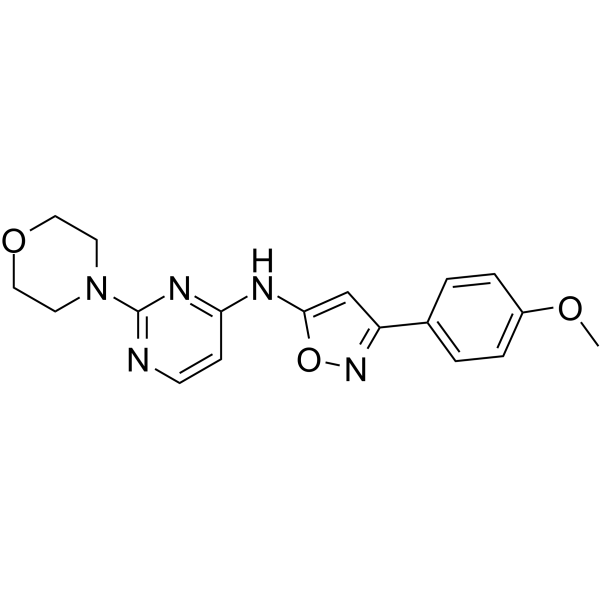产品
编 号:F288538
分子式:C18H19N5O3
分子量:353.38
分子式:C18H19N5O3
分子量:353.38
产品类型
规格
价格
是否有货
10mM*1mL in DMSO
询价
询价
1mg
询价
询价
5mg
询价
询价
10mg
询价
询价
25mg
询价
询价
结构图

CAS No: 2408648-20-2
产品详情
生物活性:
BO-264 is a highly potent and orally active transforming acidic coiled-coil 3 (TACC3) inhibitor with an IC50 of 188 nM and a Kd of 1.5 nM. BO-264 specifically blocks the function of FGFR3-TACC3 fusion protein. BO-264 induces spindle assembly checkpoint (SAC)-dependent mitotic arrest, DNA damage and apoptosis. BO-264 has broad-spectrum antitumor activity.
体内研究:
BO-264 (25 mg/kg; oral administration; daily; for 3-4 weeks; female nude mice) treatment shows a significant suppression of tumor growth. BO-264 is well tolerated since treatment does not causes a significant body weight loss and organ toxicity.Animal Model:Female nude mice injected with JIMT-1 cells
Dosage:25 mg/kg
Administration:Oral administration; daily; for 3-4 weeks
Result:Showed a significant suppression of tumor growth.
体外研究:
BO-264 (500 nM; 48 hours; JIMT-1 cells) treatment induces a prominent increase (from 4.1% to 45.6%) in the fraction of apoptotic cells as assessed by Annexin V/PI staining.BO-264 (500 nM; 24 hours; RT112 cells) treatment decreases ERK1/2 phosphorylation, which is a marker for activated FGFR signaling along with a strong mitotic arrest.BO-264 inhibits cell viability with IC50 values of 190 nM, 160 nM, 120 nM, 130 nM and 360 nM for JIMT-1, HCC1954, MDA-MB-231, MDA-MB-436 and CAL51, respectively. BO-264 specifically targets breast cancer cells while sparing normal cells. BO-264 treatment significantly reduces the average colony number of JIMT-1 cells.BO-264 inhibits the viability of cancer cells with FGFR3-TACC3 fusion with IC50 values of 0.3 μM and 3.66 μM for RT112 and RT4, respectively.BO-264 exhibits a remarkable anti-cancer activity against more than 90% of the NCI267 60 human cancer cell lines representing nine different subpanels with GI50 values less than 1 μM.BO-264 induces mitotic arrest (prominent induces p-Histone H3 (Ser10)), apoptosis (cleaved PARP) and DNA damage, causes aberrant spindle formation and reduces centrosomal localization of TACC3 in JIMT-1 cells.
BO-264 is a highly potent and orally active transforming acidic coiled-coil 3 (TACC3) inhibitor with an IC50 of 188 nM and a Kd of 1.5 nM. BO-264 specifically blocks the function of FGFR3-TACC3 fusion protein. BO-264 induces spindle assembly checkpoint (SAC)-dependent mitotic arrest, DNA damage and apoptosis. BO-264 has broad-spectrum antitumor activity.
体内研究:
BO-264 (25 mg/kg; oral administration; daily; for 3-4 weeks; female nude mice) treatment shows a significant suppression of tumor growth. BO-264 is well tolerated since treatment does not causes a significant body weight loss and organ toxicity.Animal Model:Female nude mice injected with JIMT-1 cells
Dosage:25 mg/kg
Administration:Oral administration; daily; for 3-4 weeks
Result:Showed a significant suppression of tumor growth.
体外研究:
BO-264 (500 nM; 48 hours; JIMT-1 cells) treatment induces a prominent increase (from 4.1% to 45.6%) in the fraction of apoptotic cells as assessed by Annexin V/PI staining.BO-264 (500 nM; 24 hours; RT112 cells) treatment decreases ERK1/2 phosphorylation, which is a marker for activated FGFR signaling along with a strong mitotic arrest.BO-264 inhibits cell viability with IC50 values of 190 nM, 160 nM, 120 nM, 130 nM and 360 nM for JIMT-1, HCC1954, MDA-MB-231, MDA-MB-436 and CAL51, respectively. BO-264 specifically targets breast cancer cells while sparing normal cells. BO-264 treatment significantly reduces the average colony number of JIMT-1 cells.BO-264 inhibits the viability of cancer cells with FGFR3-TACC3 fusion with IC50 values of 0.3 μM and 3.66 μM for RT112 and RT4, respectively.BO-264 exhibits a remarkable anti-cancer activity against more than 90% of the NCI267 60 human cancer cell lines representing nine different subpanels with GI50 values less than 1 μM.BO-264 induces mitotic arrest (prominent induces p-Histone H3 (Ser10)), apoptosis (cleaved PARP) and DNA damage, causes aberrant spindle formation and reduces centrosomal localization of TACC3 in JIMT-1 cells.
产品资料

